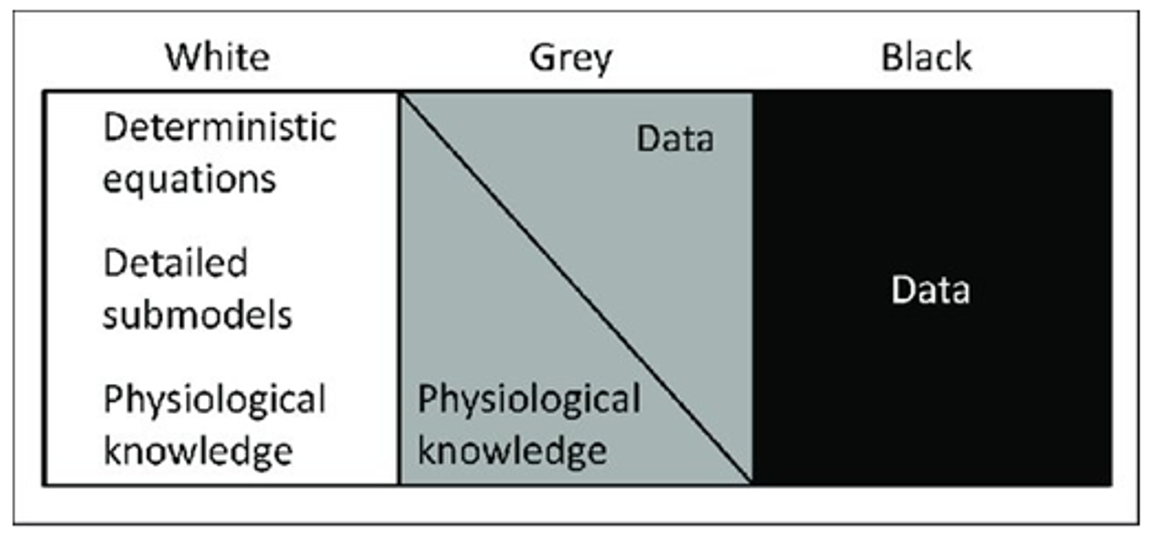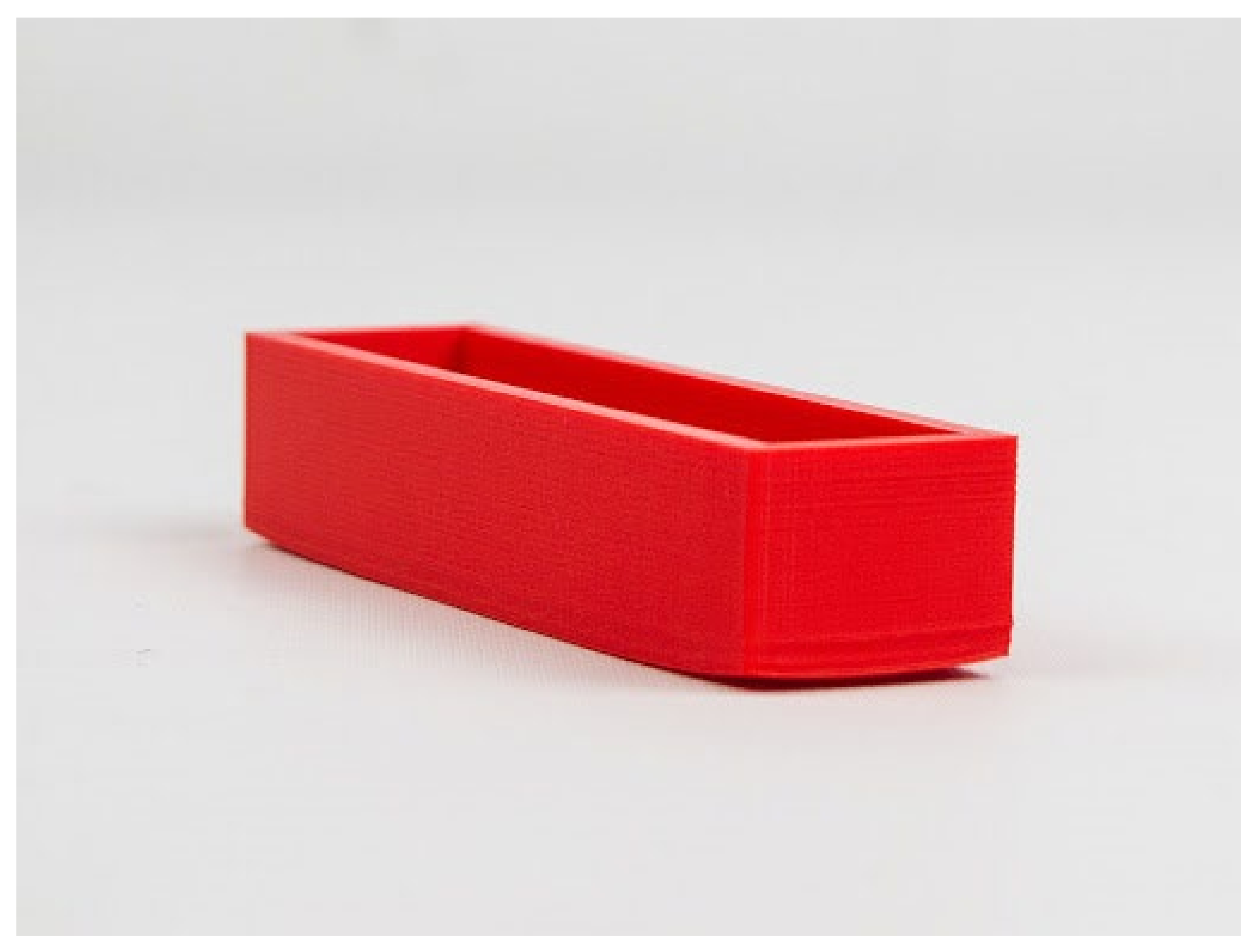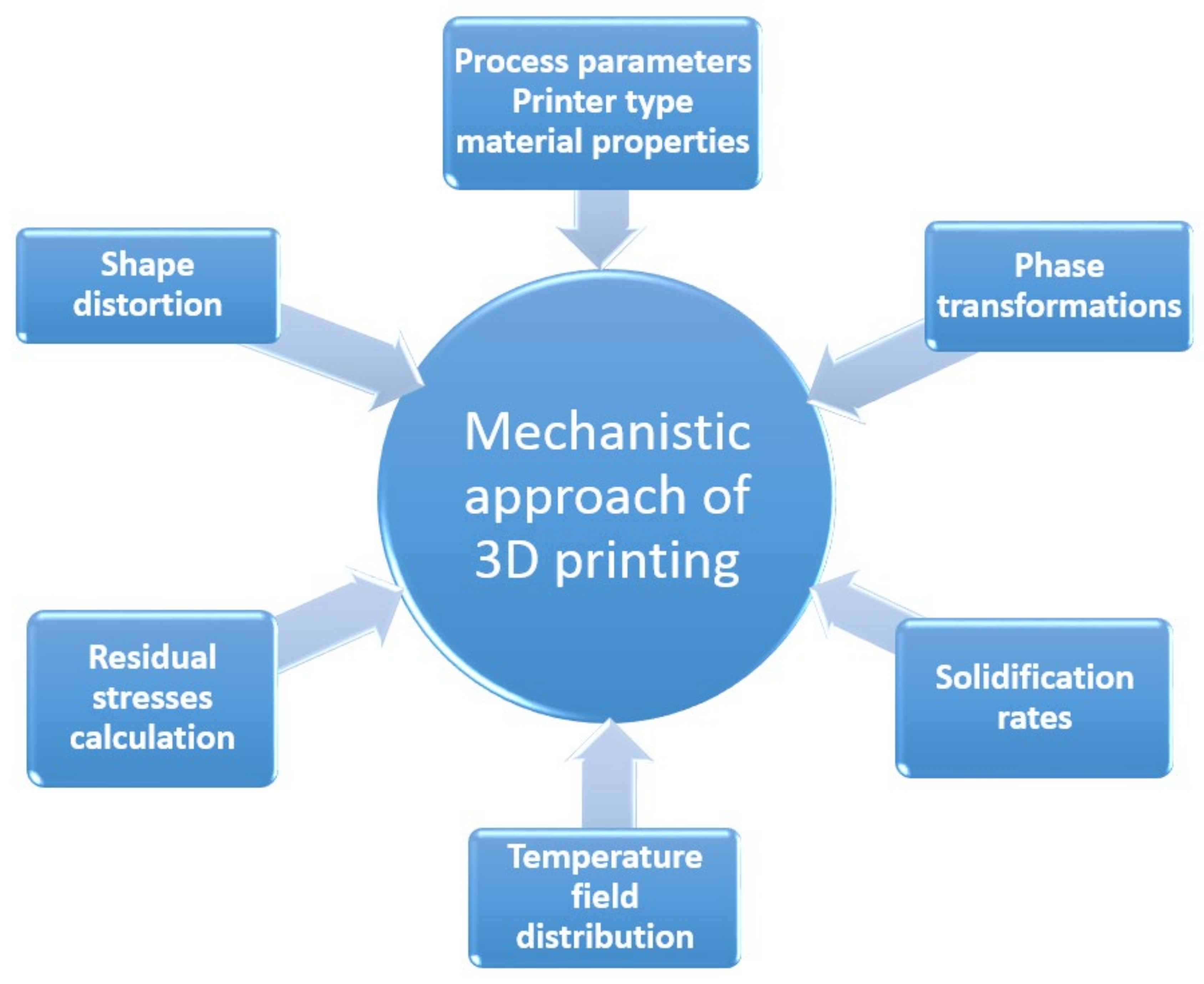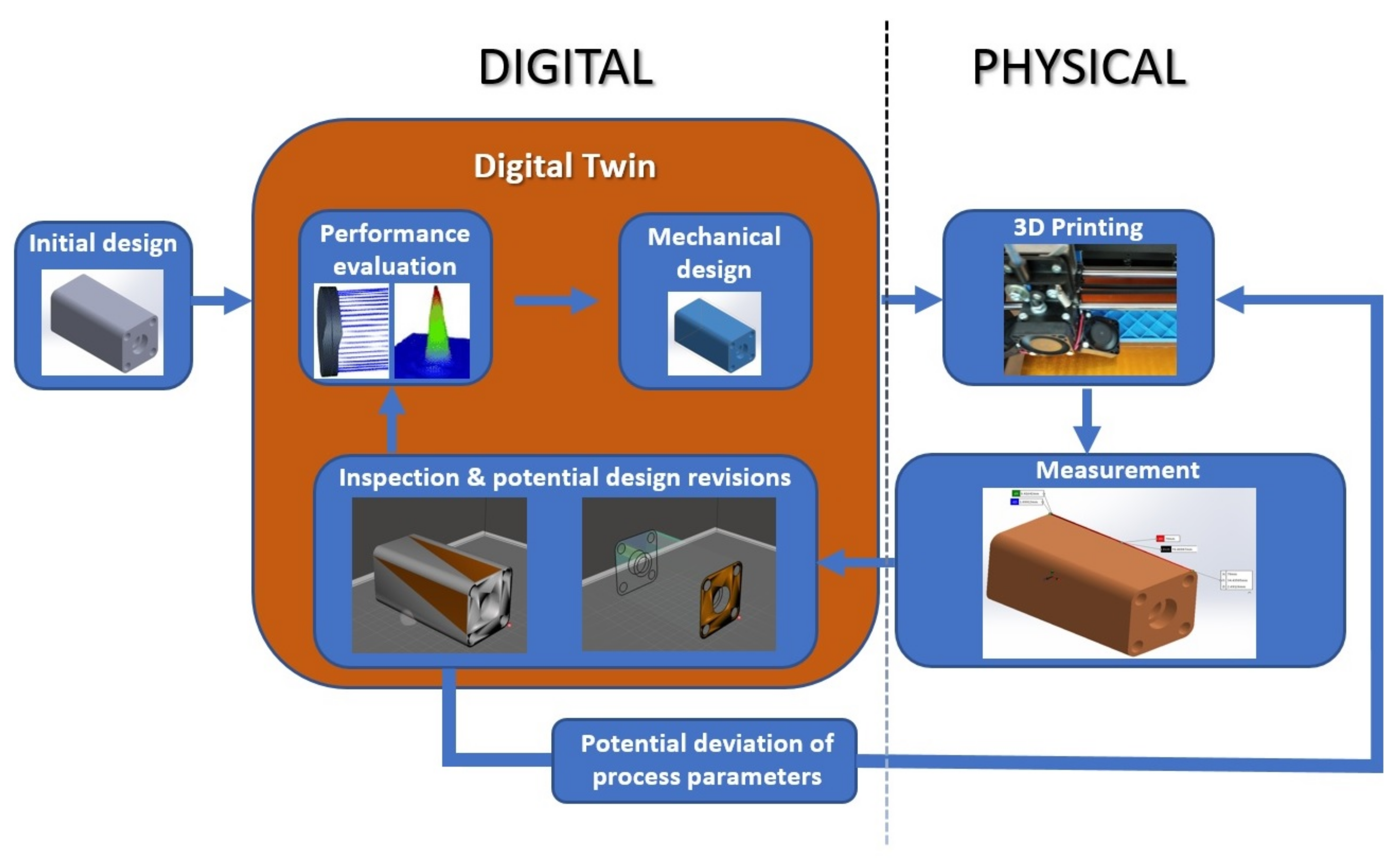Your browser does not fully support modern features. Please upgrade for a smoother experience.

Submitted Successfully!
Thank you for your contribution! You can also upload a video entry or images related to this topic.
For video creation, please contact our Academic Video Service.
| Version | Summary | Created by | Modification | Content Size | Created at | Operation |
|---|---|---|---|---|---|---|
| 1 | Antreas Kantaros | -- | 1734 | 2023-07-20 11:37:00 | | | |
| 2 | Jessie Wu | -1 word(s) | 1733 | 2023-07-21 05:37:40 | | |
Video Upload Options
We provide professional Academic Video Service to translate complex research into visually appealing presentations. Would you like to try it?
Cite
If you have any further questions, please contact Encyclopedia Editorial Office.
Kantaros, A.; Piromalis, D.; Tsaramirsis, G.; Papageorgas, P.; Tamimi, H. 3D Printing and Implementation of Digital Twins. Encyclopedia. Available online: https://encyclopedia.pub/entry/47034 (accessed on 13 January 2026).
Kantaros A, Piromalis D, Tsaramirsis G, Papageorgas P, Tamimi H. 3D Printing and Implementation of Digital Twins. Encyclopedia. Available at: https://encyclopedia.pub/entry/47034. Accessed January 13, 2026.
Kantaros, Antreas, Dimitrios Piromalis, Georgios Tsaramirsis, Panagiotis Papageorgas, Hatem Tamimi. "3D Printing and Implementation of Digital Twins" Encyclopedia, https://encyclopedia.pub/entry/47034 (accessed January 13, 2026).
Kantaros, A., Piromalis, D., Tsaramirsis, G., Papageorgas, P., & Tamimi, H. (2023, July 20). 3D Printing and Implementation of Digital Twins. In Encyclopedia. https://encyclopedia.pub/entry/47034
Kantaros, Antreas, et al. "3D Printing and Implementation of Digital Twins." Encyclopedia. Web. 20 July, 2023.
Copy Citation
Fabricating objects with desired mechanical properties by utilizing 3D printing methods can be expensive and time-consuming, especially when based only on a trial-and-error test modus operandi. Digital twins (DT) can be proposed as a solution to understand, analyze and improve the fabricated item, service system or production line. The current trends and limitations in DTs for additive manufacturing are summarized, in order to provide more insights for further research on DT systems.
3D printing
digital twins
1. Current Digital Twin Applications in 3D Printing Technologies
The compilation of successful digital twins to be applied in the various 3D printing technologies is feasible. With such cases being still relatively new, such applications face a number of challenges. The accurate digital representation of the process’s hardware and surrounding environment, along with the initial software inputs and the amount of data from different sensors to be processed, possesses a complex workflow to be followed in order to come up with a functional digital twins (DT) [1].
DebRoy et al. performed a first attempt to describe and fabricate a digital twin referring to a 3D printing process that utilized metal powder as raw material. It is described that there are simulation models capable of feeding a DT with inputs and that the combination of knowledge available in 3D printing and welding methods is preferable for making a digital twin than 3D printing techniques using metal as raw material [1]. The aspects of the process attempted to be addressed by the proposed DT are heat and material rheological simulation, solidification simulation, metal powder grain structure and texture, modeling of the material’s porous microstructure and mechanical properties as well as residual stresses and subsequent potential distortion predictions. Their proposed DT are comprised of a combination of big data and ML, a statistical model, a control and sensing model, accompanied by a mechanistic model.
Knapp et. al. proposed the development of a phenomenological framework, using the term digital twin, able to provide forecasts about the most vital parameters affecting the metallurgical properties of the 3D-printed items [2]. Per se the framework would give users the capability to provide various parameter settings to the 3D printer and, subsequently, to receive estimations about critical parameters such as transient temperature boundaries, molten pool geometrical characteristics, time and spatial alterations of cooling rates and solidification rates. Theoretically, the proposed digital twin of the 3D printing process, when sufficiently fed and validated with experimental data, would cause a shift from the current trial-and-error operating modus operandi to ‘numerical experiments’ that do not require pores of the physical world.
On the other hand, Gaikwad et al. proposed their own case of a digital twin utilized for in situ real-time monitoring of the 3D printing fabrication process as well as material defect forecast [3]. In this case, this digital twin functionality was based on the inputs of various sensors accompanied by machine learning techniques and physical-model prognosis. It was tested in directed energy deposition (DED) and laser powder-bed fusion (LPBF) metal 3D printing techniques, showing promising results.
In addition, Yang proposed the use of the well-known grey-box modeling that is being used in various other fields as well [4][5][6][7][8]. A figure indicating a grey-box model is depicted in Figure 1. The model, interestingly not coined under the term of “Digital Twin”, showed lower forecasting errors by utilizing the sensors’ data obtained and performing relevant calculations [9]. The case referred to powder-bed fusion metal 3D Printing.

Figure 1. Grey-box model.
A common feature of all the aforementioned proposed DT cases concerning additive manufacturing is their focus on metal 3D printing. This is mainly due to the fact that metal 3D printing is considered a 3D printing field characterized by elevated equipment and raw material costs. Therefore, a valid prediction of the process outcome in qualitative terms features a profound economo-technical benefit. However, the application of digital twins to 3D printing techniques such as FDM and SLA would be of great value due to their widespread use, regardless of the lower costs that these techniques share.
In this direction, Chhetri et al. proposed a digital twin case that focuses on 3D printing techniques using polymeric materials. It functions under an operating scheme that constantly obtains data about the surface texture and dimensional accuracy of the fabricated object [10]. Therefore, in this way the DT obtains data during the manufacturing procedure and makes constant real-time estimations and corrections. In another case, Khan et al. proposed a digital twin that also focused on the FDM technique, employing polymeric raw materials. This project proposes the use of a CNN deep learning model that will detect in situ real-time material defects, thus reducing the percentage of failed prints. The data input of the CNN model is derived from an integrated optical sensor in the vicinity of the printer’s extrusion nozzle.
There are also other such cases which primarily use techniques such as the finite element method, finite difference and level set methods as well as fluidic volume estimations, which are more likely to be defined under the term “simulation” than the term “Digital Twin” [11][12][13][14][15][16][17][18]. While this can be attributed to terminology, since the term digital twin is a term that has very recently arisen, in most cases computational methods and experimental-sensor-derived datasets are being utilized in a fragmented way and not under the greater umbrella of a digital twin model. Therefore, procedures such as quality control, quality monitoring or production process monitoring can be performed as stand-alone procedures, but can be also put under the greater umbrella of digital twins. By this is meant that procedures such as quality control, quality monitoring or production process monitoring can provide data (via the use of optical and other non-invasive sensors) that can be integrated into a digital twin. From that point and after, the digital twin will provide researchers with useful conclusions by also using computational techniques such as AI, ML and big data.
2. Practical Issues in Accordance with Procedure Needs
2.1. In Situ Monitoring
Opposed to traditional subtractive technologies, where in situ monitoring technology is being commonly implemented, 3D printing techniques have not yet integrated monitoring sensors, apart from experimental cases. However, current literature findings suggest that new approaches are being tested that will eventually allow for the seamless integration of monitoring techniques and lead to the desired surface quality and mechanical properties standards.
An accurate digital mapping and representation of the physical environment surrounding the 3D printer is highly desirable due to its immense role in the outcome of the process. This environment is highly dynamic and is also influenced by the human factor. Airstreams as well as humidity in the surrounding environment are known factors that can affect 3D printing items’ overall quality [19]. Therefore, it needs to be constantly and accurately monitored for the digital twin to be able to predict these interactions. In this way, in situ process monitoring is based on the analysis of in situ acquired sensor data. Specific datasets are being subsequently linked to fabricated items’ distortions and failures, geometries and specific process conditions using ML models [20][21].
Unfortunately, there are a number of drawbacks on utilizing solely data-driven approaches in order to perform the in-situ monitoring process. Firstly, a large number of completely different datasets derived from various sensors have to be acquired and processed. These can range from temperature and strain readings to high-rate imaging data. Thus, acquiring and processing of different data need to be combined with intra-system compatibility, the possibility of which remains questionable. In addition, the computational power for such an operation needs to be elevated, and in most cases desktop PCs are seldom up to this task.
Secondly, monitored factors such as built item geometrical characteristics, deposition patterns, temperatures and deposition speeds are all linked to specific acquired signal patterns; thus, data driven models need to be retrained if any of these factors change. Obviously, this causes a great concern due to the fact that such a model will not be compatible with another 3D printing technology.
Thirdly, ML models often require the acquisition of an elevated amount of input sensor data, which increases model complexity and may lead to prediction uncertainty. However, in the case of a digital twin to be utilized in the greater field of 3D printing technologies, a large amount of data is needed in order for the DT to be sufficiently trained and thereby for its long-term accuracy to be improved. Such data to be entered to the DT could be derived from real-world experiments, literature, various embedded sensors, or numerical and theoretical simulations. Gaikwad et al. [3] propose the combination of a theoretical model and a lower number of in situ sensor readings in order to reduce the computational burden as well as the amount of sensor data that need to be acquired and processed. Another suggestion could be that for each of the common 3D printing processes, there should be a predefined model for each different scenario (i.e., variety of raw materials, 3D printer environment, printer category, etc.). Thus, users would just need to input the data to use that targeted DT of their specific real-time fabrication process. However, further research is still needed to reach this point.
2.2. Valid Forecast of the 3D Printing Procedure Results
Nowadays, simulation forecasts concerning 3D-printed items mostly deal with general distortions and alterations (such as contractions from residual strains) of the pre-determined CAD-designed shape of the item as well as temperature distribution within the fabricated item’s body. Figure 2 shows such a distortion of a 3D-printed item, called warping, caused by thermally induced residual strains.

Figure 2. 3D-printed item suffering from shape distortion (lifted corners) caused thermally induced residual strains.
Such operations are based on the simplistic idea of dividing the part into different unit cells and, by computing the properties of each cell, obtaining the properties of the whole part. Figure 3 depicts a mechanistical approach model based on the literature [22].

Figure 3. Forecast mechanistical approach model for 3D printing processes.
Being able to forecast the thermal history, deformation, microstructure, proper material rheological characteristics from the extrusion nozzle and the mechanical properties is of paramount importance for the DT to make accurate predictions. Only by forecasting the aforementioned information is it possible to tailor the process parameters and gain full control of the fabrication process, to successfully monitor the surrounding environment conditions and to reach the desired results. Figure 4 depicts the process workflow of a digital twin in additive technologies.

Figure 4. Process workflow of a digital twin in additive technologies.
References
- DebRoy, T.; Zhang, W.; Turner, J.; Babu, S.S. Building digital twins of 3D printing machines. Scr. Mater. 2017, 135, 119–124.
- Knapp, G.L.; Mukherjee, T.; Zuback, J.S.; Wei, H.L.; Palmer, T.A.; De, A.; DebRoy, T. Building blocks for a digital twin of additive manufacturing. Acta Mater. 2017, 135, 390–399.
- Gaikwad, A.; Yavari, R.; Montazeri, M.; Cole, K.; Bian, L.; Rao, P. Toward the digital twin of additive manufacturing: Integrating thermal simulations, sensing, and analytics to detect process faults. IISE Trans. 2020, 52, 1204–1217.
- Pitchforth, D.J.; Rogers, T.J.; Tygesen, U.T. Grey-box models for wave loading prediction. Mech. Syst. Signal Processing 2021, 159, 107741.
- Menesklou, P.; Sinn, T.; Nirschl, H.; Gleiss, M. Grey Box Modelling of Decanter Centrifuges by Coupling a Numerical Process Model with a Neural Network. Minerals 2021, 11, 755.
- Halmschlager, V.; Müllner, S.; Hofmann, R. Mechanistic Grey-Box Modeling of a Packed-Bed Regenerator for Industrial Applications. Energies 2021, 14, 3174.
- Trojanová, M.; Čakurda, T.; Hošovský, A.; Krenický, T. Estimation of Grey-Box Dynamic Model of 2-DOF Pneumatic Actuator Robotic Arm Using Gravity Tests. Appl. Sci. 2021, 11, 4490.
- Ralph, B.J.; Hartl, K.; Sorger, M.; Schwarz-Gsaxner, A.; Stockinger, M. Machine Learning Driven Prediction of Residual Stresses for the Shot Peening Process Using a Finite Element Based Grey-Box Model Approach. J. Manuf. Mater. Process. 2021, 5, 39.
- Yang, Z. Model-Based Predictive Analytics for Additive and Smart Manufacturing. Ph.D. Thesis, University of Massachusetts, Amherst, MA, USA, 2018.
- Chhetri, S.R.; Faezi, S.; Al Faruque, M.A. Digital Twin of Manufacturing Systems: Technical Report on Digital Twin Project; Center for Embedded and Cyber-physical Systems (CECS), University of California: Irvine, CA, USA, 2017.
- Edelmers, E.; Kazoka, D.; Pilmane, M. Creation of Anatomically Correct and Optimized for 3D Printing Human Bones Models. Appl. Syst. Innov. 2021, 4, 67.
- Wojnowski, W.; Kalinowska, K.; Majchrzak, T.; Zabiegała, B. Real-time monitoring of the emission of volatile organic compounds from polylactide 3D printing filaments. Sci. Total Environ. 2022, 805, 150181.
- Bisheh, M.N.; Chang, S.I.; Lei, S. A layer-by-layer quality monitoring framework for 3D printing. Comput. Ind. Eng. 2021, 157, 107314.
- Ji, J.; Wang, M.; Hu, M.; Mao, L.; Wang, Q.; Zhou, W.; Tian, M.; Yuan, J.; Hu, K.; Wei, Y. 3D–printing AIE stereolithography resins with real−time monitored printing process to fabricate fluorescent objects. Compos. Part B Eng. 2021, 206, 108526.
- Parker, H.; Psulkowski, S.; Tran, P.; Dickens, T. In-Situ Print Characterization and Defect Monitoring of 3D Printing via Conductive Filament and Ohm’s Law. Procedia Manuf. 2021, 53, 417–426.
- Lin, X.; Zhu, K.; Zhou, J.; Fuh, J.Y.H. Intelligent modeling and monitoring of micro-droplet profiles in 3D printing. ISA Trans. 2020, 105, 367–376.
- Herren, B.; Saha, M.C.; Altan, M.J.; Liu, Y. Development of ultrastretchable and skin attachable nanocomposites for human motion monitoring via embedded 3D printing. Compos. Part B Eng. 2020, 200, 108224.
- Dissanayake, M.; Suntharalingam, T.; Tsavdaridis, K.D.; Poologanathan, K.; Perampalam, G. Informed Finite Element Modelling for Wire and Arc Additively Manufactured Metallics—A Case Study on Modular Building Connections. Buildings 2022, 12, 5.
- Kantaros, A.; Piromalis, D. Employing a Low-Cost Desktop 3D Printer: Challenges, and How to Overcome Them by Tuning Key Process Parameters. Int. J. Mech. Appl. 2021, 10, 11–19.
- Grasso, M.; Colosimo, B.M. Process defects and in situ monitoring methods in metal powder bed fusion: A review. Meas. Sci. Technol. 2018, 28, 044005.
- Mani, M.; Lane, B.M.; Donmez, M.A.; Feng, S.C.; Moylan, S.P. A review on measurement science needs for real-time control of additive manufacturing metal powder bed fusion processes. Int. J. Prod. Res. 2017, 55, 1400–1418.
- Mukherjee, T.; DebRoy, T. A digital twin for rapid qualification of 3D printed metallic components. Appl. Mater. Today 2019, 14, 59–65.
More
Information
Subjects:
Automation & Control Systems
Contributors
MDPI registered users' name will be linked to their SciProfiles pages. To register with us, please refer to https://encyclopedia.pub/register
:
View Times:
926
Revisions:
2 times
(View History)
Update Date:
21 Jul 2023
Notice
You are not a member of the advisory board for this topic. If you want to update advisory board member profile, please contact office@encyclopedia.pub.
OK
Confirm
Only members of the Encyclopedia advisory board for this topic are allowed to note entries. Would you like to become an advisory board member of the Encyclopedia?
Yes
No
${ textCharacter }/${ maxCharacter }
Submit
Cancel
Back
Comments
${ item }
|
More
No more~
There is no comment~
${ textCharacter }/${ maxCharacter }
Submit
Cancel
${ selectedItem.replyTextCharacter }/${ selectedItem.replyMaxCharacter }
Submit
Cancel
Confirm
Are you sure to Delete?
Yes
No




